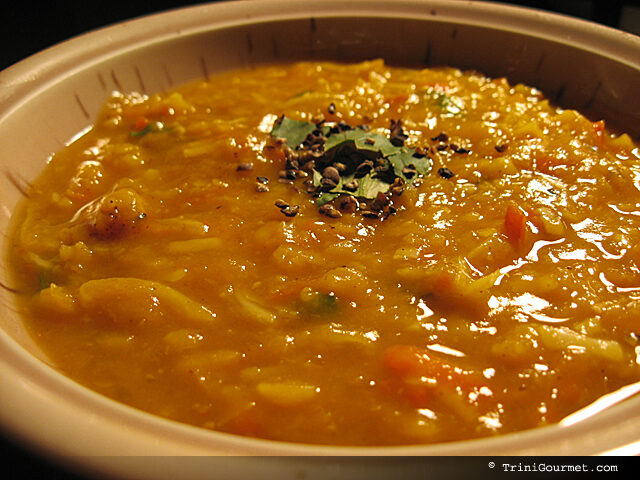Tridoshic Dal (recipe)


This Tridoshic dal comes from a cookbook that I’ve been using for years called The Ayurvedic Cookbook.
I’m always interested in learning about the culinary traditions and philosophies of other cultures. Eastern cuisines in particular often fixates on the concept of warming and cooling foods. Maintaining a balance of the two within a meal, or strategically stimulating or calming ones system where imbalance is detected. This approach to balance and harmony has interestingly enough infused my approach to even Caribbean/Western cooking. I find myself trying to create harmony within dishes, adding cooling tomatoes when using fiery peppers for example.
According to The Ayurvedic Cookbook, all of us fall into one of three doshas or body types – Vita, Pitta and Kapha. (For those who are insufferably curious I am a Pitta 🙂 ). Not understanding our respective types can cause us to unknowingly indulge in foods that work against our personal chemistry. Interestingly enough when looking at the foods that Pitta is supposed to avoid I saw more than a few that I have instinctively avoided/disliked since childhood!
Each recipe in The Ayurvedic Cookbook lists whether it is aggravating, calming or neutral where each dosha is concerned. Dals like this one, being tridoshic, are ideal for all body types, which is wonderful because it tastes soo soo good. Aromatic with chadon beni, coconut, geera (cumin) seeds, and pumpkin. Although I still make a more traditional Trinidadian dal, this is currently my dal of all dals. There is just something about the way that the sweetness of the pumpkin compliments the creamy warmth of the split peas and once the coconut and cilantro are stirred in at the end, oh my! Flavour fuh so! For my own personal tastes I added a tad more coconut than would qualify as a ‘garnish’, and I also use an immersion blender at the end to partially puree the liquid. With Divali fast approaching why not give it a try and let me know 🙂
From The Ayurvedic Cookbook
:
Dals are always prepared with something sour in the vagar (mixture of spices and ghee)
to stimulate digestive fire. In [Mumbai], tamarind is often used, while in the Gujarati province, lemon, lime or amchoor add this stimulating sourness. It must be added in the early stages of cooking for best effect.Want to learn more?
Tridoshic Dal
Source: The Ayurvedic Cookbook
Preparation time : 1 hour
Serves : 6
INGREDIENTS:
1 cup split mung dal
8 cups water
2 cups summer squash, in 1/4 to 1/2 inch slices
1 cup carrots, in 1/4 to 1/2 inch slices
1/8 teaspoon hing
2 tablespoons sunflower oil or ghee
1-1/4 teaspoons turmeric
1 tablespoon lime or lemon juice or 1 tablespoon amchoor (dried mango powder)
1 teaspoon sea salt
1/2 tablespoon fresh ginger root, minced
1 small hot green pepper, chopped finely or 1/4 cup prepared salsa (omit for Pitta, and easy on this for Vata)
1-1/4 tablespoon cumin seeds
1/2 teaspoon to 1 tablespoon black mustard seeds
Garmish ; Fresh coriander leaves, chopped and shredded unsweetened coconut
METHOD:
Wash dal until rinse water is clear. Wash and chop vegetables.
1. Warm 1 tablespoon oil or ghee in large heavy saucepan.
2. Add hing, turmeric, and lemon juice and saute for 30 seconds over low heat (be careful, it is easy for turmeric
to burn).
3. Stir in the beans and saute for another 1 to 2 minutes.
4. Add the chopped vegetables and stir another minute or two.
5. Add water, salt, ginger, and pepper (if you are using it); bring to a boil on high heat. Then cover and reduce heat to medium-low.
6. Let soup simmer for 45 minutes or until beans have dissolved.
7. Warm remaining tablespoon of oil or ghee in a small skillet, add cumin and mustard seeds, heat until the mustard seeds begin to pop.
8. Add to soup, which is now ready to serve.
9. Garnish with fresh chopped coriander leaves and coconut.
NUTRITION FACTS
Servings: 6
Amount Per Serving
Calories: 175
Total Fat: 5.01g
Cholesterol: —
Sodium: 98mg
Total Carbs: 24.98g
Dietary Fiber: 9.74g
Sugars: 5.24g
Protein: 9.10g
This post was originally published September 15, 2009. It has been updated once since then.
